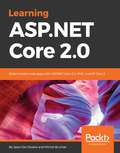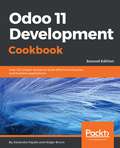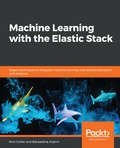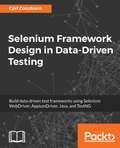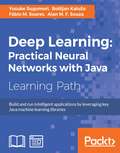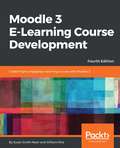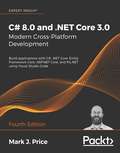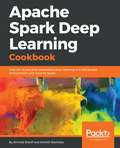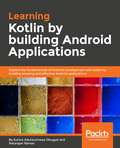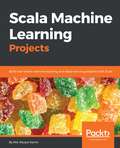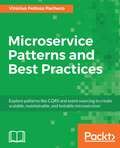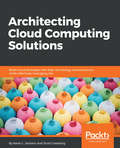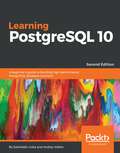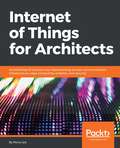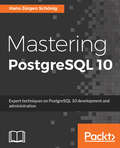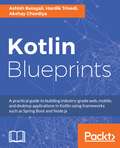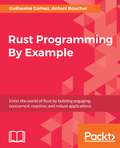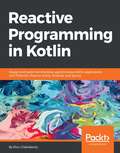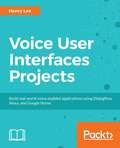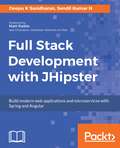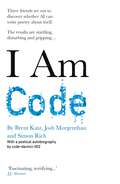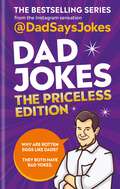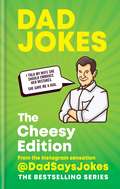- Table View
- List View
Learning ASP.NET Core 2.0
by Jason De Oliveira Michel BruchetLearn how web applications can be built efficiently using ASP.NET Core 2.0 and related frameworks About This Book • Get to grips with the new features and APIs introduced in ASP.NET Core 2.0 • Leverage the MVC framework and Entity Framework Core 2 to build efficient applications • Learn to deploy your web applications in new environments such as the cloud and Docker Who This Book Is For This book is for developers who would like to build modern web applications with ASP.NET Core 2.0. No prior knowledge of ASP.NET or .NET Core is required. However, basic programming knowledge is assumed. Additionally, previous Visual Studio experience will be helpful but is not required, since detailed instructions will guide through the samples of the book.This book can also help people, who work in infrastructure engineering and operations, to monitor and diagnose problems during the runtime of ASP.NET Core 2.0 web applications. What You Will Learn • Set up your development environment using Visual Studio 2017 and Visual Studio Code • Create a fully automated continuous delivery pipeline using Visual Studio Team Services • Get to know the basic and advanced concepts of ASP.NET Core 2.0 with detailed examples • Build an MVC web application and use Entity Framework Core 2 to access data • Add Web APIs to your web applications using RPC, REST, and HATEOAS • Authenticate and authorize users with built-in ASP.NET Core 2.0 features • Use Azure, Amazon Web Services, and Docker to deploy and monitor your applications In Detail The ability to develop web applications that are highly efficient but also easy to maintain has become imperative to many businesses. ASP.NET Core 2.0 is an open source framework from Microsoft, which makes it easy to build cross-platform web applications that are modern and dynamic. This book will take you through all of the essential concepts in ASP.NET Core 2.0, so you can learn how to build powerful web applications. The book starts with a brief introduction to the ASP.NET Core framework and the improvements made in the latest release, ASP.NET Core 2.0. You will then build, test, and debug your first web application very quickly. Once you understand the basic structure of ASP.NET Core 2.0 web applications, you'll dive deeper into more complex concepts and scenarios. Moving on, we'll explain how to take advantage of widely used frameworks such as Model View Controller and Entity Framework Core 2 and you'll learn how to secure your applications. Finally, we'll show you how to deploy and monitor your applications using Azure, AWS, and Docker. After reading the book, you'll be able to develop efficient and robust web applications in ASP.NET Core 2.0 that have high levels of customer satisfaction and adoption. Style and approach Start an exciting journey to building high performance web applications using ASP.NET Core 2.0 and MVC
Odoo 11 Development Cookbook, Second Edition: Over 120 Unique Recipes To Build Effective Enterprise And Business Applications
by Alexandre FayolleOdoo is a full-featured open source ERP with a focus on extensibility. The flexibility and sustainability of open source is also a key selling point of Odoo. It is built on a powerful framework for rapid application development, both for back-end applications and front-end websites. The latest v10 has quite a few updates that will interest developers. The book starts by covering Odoo installation and administration and then dives deep into Odoo Server deployment.
Machine Learning with the Elastic Stack: Expert techniques to integrate machine learning with distributed search and analytics
by Bahaaldine Azarmi Rich CollierLeverage Elastic Stack's machine learning features to gain valuable insight from your data Key Features Combine machine learning with the analytic capabilities of Elastic Stack Analyze large volumes of search data and gain actionable insight from them Use external analytical tools with your Elastic Stack to improve its performance Book Description Machine Learning with the Elastic Stack is a comprehensive overview of the embedded commercial features of anomaly detection and forecasting. The book starts with installing and setting up Elastic Stack. You will perform time series analysis on varied kinds of data, such as log files, network flows, application metrics, and financial data. As you progress through the chapters, you will deploy machine learning within the Elastic Stack for logging, security, and metrics. In the concluding chapters, you will see how machine learning jobs can be automatically distributed and managed across the Elasticsearch cluster and made resilient to failure. By the end of this book, you will understand the performance aspects of incorporating machine learning within the Elastic ecosystem and create anomaly detection jobs and view results from Kibana directly. What you will learn Install the Elastic Stack to use machine learning features Understand how Elastic machine learning is used to detect a variety of anomaly types Apply effective anomaly detection to IT operations and security analytics Leverage the output of Elastic machine learning in custom views, dashboards, and proactive alerting Combine your created jobs to correlate anomalies of different layers of infrastructure Learn various tips and tricks to get the most out of Elastic machine learning Who this book is for If you are a data professional eager to gain insight on Elasticsearch data without having to rely on a machine learning specialist or custom development, Machine Learning with the Elastic Stack is for you. Those looking to integrate machine learning within their search and analytics applications will also find this book very useful. Prior experience with the Elastic Stack is needed to get the most out of this book.
Selenium Framework Design in Data-Driven Testing: Build data-driven test frameworks using Selenium WebDriver, AppiumDriver, Java, and TestNG
by Carl Cocchiaro Pinakin Ashok ChaubalTake a deep dive into building data-driven test frameworks using Selenium WebDriver Key Features A comprehensive guide to designing data-driven test frameworks using the Selenium 3 WebDriver API, AppiumDriver API, Java-Bindings, and TestNG Learn how to use Selenium Page Object Design Patterns and D.R.Y. (Don’t Repeat Yourself) Approaches to software development in automated testing Discover the Selenium Grid Architecture and build your own grid for browser and mobile devices Use third party tools and services like ExtentReports for results processing, reporting, and SauceLabs for cloud-based test services Book Description The Selenium WebDriver 3.x Technology is an open source API available to test both Browser and Mobile applications. It is completely platform independent in that tests built for one browser or mobile device, will also work on all other browsers and mobile devices. Selenium supports all major development languages which allow it to be tied directly into the technology used to develop the applications. This guide will provide a step-by-step approach to designing and building a data-driven test framework using Selenium WebDriver, Java, and TestNG. The book starts off by introducing users to the Selenium Page Object Design Patterns and D.R.Y Approaches to Software Development. In doing so, it covers designing and building a Selenium WebDriver framework that supports both Browser and Mobile Devices. It will lead the user through a journey of architecting their own framework with a scalable driver class, Java utility classes, JSON Data Provider, Data-Driven Test Classes, and support for third party tools and plugins. Users will learn how to design and build a Selenium Grid from scratch to allow the framework to scale and support different browsers, mobile devices, versions, and platforms, and how they can leverage third party grids in the Cloud like SauceLabs. Other topics covered include designing abstract base and sub-classes, inheritance, dual-driver support, parallel testing, testing multi-branded applications, best practices for using locators, and data encapsulation. Finally, you will be presented with a sample fully-functional framework to get them up and running with the Selenium WebDriver for browser testing. By the end of the book, you will be able to design your own automation testing framework and perform data-driven testing with Selenium WebDriver. What you will learn Design the Selenium Driver Class for local, remote, and third party grid support Build Page Object Classes using the Selenium Page Object Model Develop Data-Driven Test Classes using the TestNG framework Encapsulate Data using the JSON Protocol Build a Selenium Grid for RemoteWebDriver Testing Construct Utility Classes for use in Synchronization, File I/O, Reporting and Test Listener Classes Run the sample framework and see the benefits of a live data-driven framework in real-time Who this book is for This book is intended for software quality assurance/testing professionals, software project managers, or software developers with prior experience in using Selenium and Java to test web-based applications.This book is geared towards the quality assurance and development professionals responsible for designing and building enterprise-based testing frameworks.The user should have a working knowledge of the Java, TestNG, and Selenium technologies
Deep Learning: Practical Neural Networks with Java
by Bostjan Kaluza Fabio M. Soares Yusuke Sugomori Alan M. SouzaBuild and run intelligent applications by leveraging key Java machine learning libraries About This Book • Develop a sound strategy to solve predictive modelling problems using the most popular machine learning Java libraries. • Explore a broad variety of data processing, machine learning, and natural language processing through diagrams, source code, and real-world applications • This step-by-step guide will help you solve real-world problems and links neural network theory to their application Who This Book Is For This course is intended for data scientists and Java developers who want to dive into the exciting world of deep learning. It will get you up and running quickly and provide you with the skills you need to successfully create, customize, and deploy machine learning applications in real life. What You Will Learn • Get a practical deep dive into machine learning and deep learning algorithms • Explore neural networks using some of the most popular Deep Learning frameworks • Dive into Deep Belief Nets and Stacked Denoising Autoencoders algorithms • Apply machine learning to fraud, anomaly, and outlier detection • Experiment with deep learning concepts, algorithms, and the toolbox for deep learning • Select and split data sets into training, test, and validation, and explore validation strategies • Apply the code generated in practical examples, including weather forecasting and pattern recognition In Detail Machine learning applications are everywhere, from self-driving cars, spam detection, document search, and trading strategies, to speech recognitionStarting with an introduction to basic machine learning algorithms, this course takes you further into this vital world of stunning predictive insights and remarkable machine intelligence. This course helps you solve challenging problems in image processing, speech recognition, language modeling. You will discover how to detect anomalies and fraud, and ways to perform activity recognition, image recognition, and text. You will also work with examples such as weather forecasting, disease diagnosis, customer profiling, generalization, extreme machine learning and more. By the end of this course, you will have all the knowledge you need to perform deep learning on your system with varying complexity levels, to apply them to your daily work. The course provides you with highly practical content explaining deep learning with Java, from the following Packt books: 1. Java Deep Learning Essentials 2. Machine Learning in Java 3. Neural Network Programming with Java, Second Edition Style and approach This course aims to create a smooth learning path that will teach you how to effectively use deep learning with Java with other de facto components to get the most out of it. Through this comprehensive course, you'll learn the basics of predictive modelling and progress to solve real-world problems and links neural network theory to their application
Moodle 3 E-Learning Course Development: Create highly engaging and interactive e-learning courses with Moodle 3, 4th Edition
by Susan Smith NashA complete guide on course development and delivery using Moodle 3.xKey FeaturesGet the best out of the latest Moodle 3 framework to ensure successful learningCreate 3rd party plugins and widgets and secure your course efficientlyCreate your first Moodle VR app using the Moodle VR toolsetBook DescriptionMoodle is a learning platform or Course Management System (CMS) that is easy toinstall and use, but the real challenge is in developing a learning process that leverages its power and maps the learning objectives to content and assessments for an integrated and effective course. Moodle 3 E-Learning Course Development guides you through meeting that challenge in a practical way.This latest edition will show you how to add static learning material, assessments, and social features such as forum-based instructional strategy, a chat module, and forums to your courses so that students reach their learning potential. Whether you want tosupport traditional class teaching or lecturing, or provide complete online and distancee-learning courses, this book will prove to be a powerful resource throughoutyour use of Moodle.You’ll learn how to create and integrate third-party plugins and widgets in your Moodle app, implement site permissions and user accounts, and ensure the security of content and test papers. Further on, you’ll implement PHP scripts that will help you create customized UIs for your app. You’ll also understand how to create your first Moodle VR e-learning app using the latest VR learning experience that Moodle 3 has to offer.By the end of this book, you will have explored the decisions, design considerations, andthought processes that go into developing a successful course.What you will learnKnow what Moodle does and how it supports your teaching strategiesInstall Moodle on your computer and navigate your way around itUnderstand all of Moodle's learning featuresMonitor how learners interact with your site using site statisticsAdd multimedia content to your siteAllow students to enroll themselves or invite other students to join a courseWho this book is forThis book is for anyone who wants to get the best out of Moodle. As a beginner, this is a thorough guide for you to understand how the software works, with great ideas for getting off to a good start with your first course. Some experience of working with e-learning systems will be beneficial. Experienced Moodle users will find powerful insights into developing successful and educational courses.
C# 8.0 and .NET Core 3.0 – Modern Cross-Platform Development - Fourth Edition: Build applications with C#, .NET Core, Entity Framework Core, ASP.NET Core, and ML.NET using Visual Studio Code, 4th Edition
by Mark J. PriceReaders with some prior programming experience or with a science, technology, engineering, or mathematics (STEM) background, who want to gain a solid foundation with C# 8.0 and .NET Core 3.0.
Apache Spark Deep Learning Cookbook: Over 80 recipes that streamline deep learning in a distributed environment with Apache Spark
by Ahmed Sherif Amrith RavindraA solution-based guide to put your deep learning models into production with the power of Apache SparkKey FeaturesDiscover practical recipes for distributed deep learning with Apache SparkLearn to use libraries such as Keras and TensorFlow Solve problems in order to train your deep learning models on Apache SparkBook DescriptionWith deep learning gaining rapid mainstream adoption in modern-day industries, organizations are looking for ways to unite popular big data tools with highly efficient deep learning libraries. As a result, this will help deep learning models train with higher efficiency and speed. With the help of the Apache Spark Deep Learning Cookbook, you’ll work through specific recipes to generate outcomes for deep learning algorithms, without getting bogged down in theory. From setting up Apache Spark for deep learning to implementing types of neural net, this book tackles both common and not so common problems to perform deep learning on a distributed environment. In addition to this, you’ll get access to deep learning code within Spark that can be reused to answer similar problems or tweaked to answer slightly different problems. You will also learn how to stream and cluster your data with Spark. Once you have got to grips with the basics, you’ll explore how to implement and deploy deep learning models, such as Convolutional Neural Networks (CNN) and Recurrent Neural Networks (RNN) in Spark, using popular libraries such as TensorFlow and Keras.By the end of the book, you'll have the expertise to train and deploy efficient deep learning models on Apache Spark.What you will learn Set up a fully functional Spark environment Understand practical machine learning and deep learning concepts Apply built-in machine learning libraries within Spark Explore libraries that are compatible with TensorFlow and Keras Explore NLP models such as Word2vec and TF-IDF on Spark Organize dataframes for deep learning evaluation Apply testing and training modeling to ensure accuracy Access readily available code that may be reusableWho this book is forIf you’re looking for a practical and highly useful resource for implementing efficiently distributed deep learning models with Apache Spark, then the Apache Spark Deep Learning Cookbook is for you. Knowledge of the core machine learning concepts and a basic understanding of the Apache Spark framework is required to get the best out of this book. Additionally, some programming knowledge in Python is a plus.
Learning Kotlin by building Android Applications: Explore the fundamentals of Kotlin by building real-world Android applications
by Eunice Adutwumwaa Obugyei Natarajan RamanLearn programming in Kotlin including data types, flow control, lambdas, object-oriented, and functional programming while building 3 Android AppsKey FeaturesExperience the gentle learning curve of Kotlin as you develop your own applicationsLearn how to integrate Kotlin into Android Studio 3 and use it in your projectsBuild real-world applications such as Googly Eyes and games using KotlinBook DescriptionToday Kotlin is an official programming language for Android development and is widely adopted. Kotlin is expressive, concise, and powerful. It also ensures seamless interoperability with existing Android languages like JAVA and C++, which means that it's even easier for developers to use. This book adopts a project-style approach, where we focus on teaching Android development by building three different Android Application: a Tic-Tac-Toe application, a location- based alarm and a To-Do list application.The book begins by giving you a strong grasp of the Kotlin language and its APIs as a preliminary to building stunning applications for Android. You'll learn to set up an environment and as you progress through the chapters and the building of the different applications, the difficulty level will steadily grow.The book also introduces you to the Android Studio IDE, which plays an integral role in Android Development. It covers Kotlin's basic programming concepts such as functions, lambdas, properties, object-oriented code, safety aspects and type parameterization, testing, and concurrency, and helps you write Kotlin code to production.Finally, you'll be taken through the process of releasing your app on the Google Play Store. You will also be introduced to other app distribution channels such as Amazon App Store.As a bonus chapter, you will also learn how to use the Google Faces API to detect faces and add fun functionalities.What you will learnLearn the basics of using the Android Studio IDE and a number of basic programming concepts in KotlinDiscover Android development by building Android apps with KotlinUncover some amazing features of Kotlin that give it the upper hand over JavaLearn about Kotlin interoperability with JavaIntegrate Crashlytics for crash reporting and beta testing.Use Google Location services and understand various APIs available for getting user location updatesUnderstand the principles of networking and communication. Learn about the usage of third-party libraries for loading of dataAutomate your build process with continuous integration tools Who this book is forIf you are completely new to Kotlin or the Android platform and need to publish Android applications for fun or for business purposes, but you have no clue where to start, then this book is for you. This book is also for advanced Android developers who want to learn to use Kotlin instead of/alongside Java for Android development, although having some programming experience would be helpful.
Scala Machine Learning Projects: Build real-world machine learning and deep learning projects with Scala
by Md. Rezaul KarimPowerful smart applications using deep learning algorithms to dominate numerical computing, deep learning, and functional programming. Key Features Explore machine learning techniques with prominent open source Scala libraries such as Spark ML, H2O, MXNet, Zeppelin, and DeepLearning4j Solve real-world machine learning problems by delving complex numerical computing with Scala functional programming in a scalable and faster way Cover all key aspects such as collection, storing, processing, analyzing, and evaluation required to build and deploy machine models on computing clusters using Scala Play framework. Book Description Machine learning has had a huge impact on academia and industry by turning data into actionable information. Scala has seen a steady rise in adoption over the past few years, especially in the fields of data science and analytics. This book is for data scientists, data engineers, and deep learning enthusiasts who have a background in complex numerical computing and want to know more hands-on machine learning application development. If you're well versed in machine learning concepts and want to expand your knowledge by delving into the practical implementation of these concepts using the power of Scala, then this book is what you need! Through 11 end-to-end projects, you will be acquainted with popular machine learning libraries such as Spark ML, H2O, DeepLearning4j, and MXNet. At the end, you will be able to use numerical computing and functional programming to carry out complex numerical tasks to develop, build, and deploy research or commercial projects in a production-ready environment. What you will learn Apply advanced regression techniques to boost the performance of predictive models Use different classification algorithms for business analytics Generate trading strategies for Bitcoin and stock trading using ensemble techniques Train Deep Neural Networks (DNN) using H2O and Spark ML Utilize NLP to build scalable machine learning models Learn how to apply reinforcement learning algorithms such as Q-learning for developing ML application Learn how to use autoencoders to develop a fraud detection application Implement LSTM and CNN models using DeepLearning4j and MXNetWho this book is for If you want to leverage the power of both Scala and Spark to make sense of Big Data, then this book is for you. If you are well versed with machine learning concepts and wants to expand your knowledge by delving into the practical implementation using the power of Scala, then this book is what you need! Strong understanding of Scala Programming language is recommended. Basic familiarity with machine Learning techniques will be more helpful.
Microservice Patterns and Best Practices: Explore patterns like CQRS and event sourcing to create scalable, maintainable, and testable microservices
by Vinicius Feitosa PachecoExplore the concepts and tools you need to discover the world of microservices with various design patterns Key Features Get to grips with the microservice architecture and build enterprise-ready microservice applications Learn design patterns and the best practices while building a microservice application Obtain hands-on techniques and tools to create high-performing microservices resilient to possible fails Book Description Microservices are a hot trend in the development world right now. Many enterprises have adopted this approach to achieve agility and the continuous delivery of applications to gain a competitive advantage. This book will take you through different design patterns at different stages of the microservice application development along with their best practices. Microservice Patterns and Best Practices starts with the learning of microservices key concepts and showing how to make the right choices while designing microservices. You will then move onto internal microservices application patterns, such as caching strategy, asynchronism, CQRS and event sourcing, circuit breaker, and bulkheads. As you progress, you'll learn the design patterns of microservices. The book will guide you on where to use the perfect design pattern at the application development stage and how to break monolithic application into microservices. You will also be taken through the best practices and patterns involved while testing, securing, and deploying your microservice application. At the end of the book, you will easily be able to create interoperable microservices, which are testable and prepared for optimum performance. What you will learn How to break monolithic application into microservices Implement caching strategies, CQRS and event sourcing, and circuit breaker patterns Incorporate different microservice design patterns, such as shared data, aggregator, proxy, and chained Utilize consolidate testing patterns such as integration, signature, and monkey tests Secure microservices with JWT, API gateway, and single sign on Deploy microservices with continuous integration or delivery, Blue-Green deployment Who this book is for This book is for architects and senior developers who would like implement microservice design patterns in their enterprise application development. The book assumes some prior programming knowledge.
Architecting Cloud Computing Solutions: Build cloud strategies that align technology and economics while effectively managing risk
by Kevin L. Jackson Scott GoesslingAccelerating Business and Mission Success with Cloud Computing.Key FeaturesA step-by-step guide that will practically guide you through implementing Cloud computing services effectively and efficiently. Learn to choose the most ideal Cloud service model, and adopt appropriate Cloud design considerations for your organization.Leverage Cloud computing methodologies to successfully develop a cost-effective Cloud environment successfully. Book DescriptionCloud adoption is a core component of digital transformation. Scaling the IT environment, making it resilient, and reducing costs are what organizations want. Architecting Cloud Computing Solutions presents and explains critical Cloud solution design considerations and technology decisions required to choose and deploy the right Cloud service and deployment models, based on your business and technology service requirements.This book starts with the fundamentals of cloud computing and its architectural concepts. It then walks you through Cloud service models (IaaS, PaaS, and SaaS), deployment models (public, private, community, and hybrid) and implementation options (Enterprise, MSP, and CSP) to explain and describe the key considerations and challenges organizations face during cloud migration. Later, this book delves into how to leverage DevOps, Cloud-Native, and Serverless architectures in your Cloud environment and presents industry best practices for scaling your Cloud environment. Finally, this book addresses (in depth) managing essential cloud technology service components such as data storage, security controls, and disaster recovery. By the end of this book, you will have mastered all the design considerations and operational trades required to adopt Cloud services, no matter which cloud service provider you choose. What you will learn Manage changes in the digital transformation and cloud transition process Design and build architectures that support specific business cases Design, modify, and aggregate baseline cloud architectures Familiarize yourself with cloud application security and cloud computing security threats Design and architect small, medium, and large cloud computing solutionsWho this book is forIf you are an IT Administrator, Cloud Architect, or a Solution Architect keen to benefit from cloud adoption for your organization, then this book is for you.Small business owners, managers, or consultants will also find this book useful. No prior knowledge of Cloud computing is needed.
Learning PostgreSQL 10 - Second Edition: A beginner's guide to building high-performance PostgreSQL database solutions
by Salahaldin Juba Andrey VolkovLeverage the power of PostgreSQL 10 to build powerful database and data warehousing applications. About This Book • Be introduced to the concept of relational databases and PostgreSQL, one of the fastest growing open source databases in the world • Learn client-side and server-side programming in PostgreSQL, and how to administer PostgreSQL databases • Discover tips on implementing efficient database solutions with PostgreSQL 10 Who This Book Is For If you're interested in learning more about PostgreSQL - one of the most popular relational databases in the world, then this book is for you. Those looking to build solid database or data warehousing applications with PostgreSQL 10 will also find this book a useful resource. No prior knowledge of database programming or administration is required to get started with this book. What You Will Learn • Understand the fundamentals of relational databases, relational algebra, and data modeling • Install a PostgreSQL cluster, create a database, and implement your data model • Create tables and views, define indexes, and implement triggers, stored procedures, and other schema objects • Use the Structured Query Language (SQL) to manipulate data in the database • Implement business logic on the server side with triggers and stored procedures using PL/pgSQL • Make use of advanced data types supported by PostgreSQL 10: Arrays, hstore, JSONB, and others • Develop OLAP database solutions using the most recent features of PostgreSQL 10 • Connect your Python applications to a PostgreSQL database and work with the data efficiently • Test your database code, find bottlenecks, improve performance, and enhance the reliability of the database applications In Detail PostgreSQL is one of the most popular open source databases in the world, and supports the most advanced features included in SQL standards and beyond. This book will familiarize you with the latest new features released in PostgreSQL 10, and get you up and running with building efficient PostgreSQL database solutions from scratch. We'll start with the concepts of relational databases and their core principles. Then you'll get a thorough introduction to PostgreSQL and the new features introduced in PostgreSQL 10. We'll cover the Data Definition Language (DDL) with an emphasis on PostgreSQL, and the common DDL commands supported by ANSI SQL. You'll learn to create tables, define integrity constraints, build indexes, and set up views and other schema objects. Moving on, you'll get to know the concepts of Data Manipulation Language (DML) and PostgreSQL server-side programming capabilities using PL/pgSQL. This will give you a very robust background to develop, tune, test, and troubleshoot your database application. We'll also explore the NoSQL capabilities of PostgreSQL and connect to your PostgreSQL database to manipulate data objects. By the end of this book, you'll have a thorough understanding of the basics of PostgreSQL 10 and will have the necessary skills to build efficient database solutions. Style and approach This book is a comprehensive beginner level tutorial on PostgreSQL and introduces the features of the newest version 10, along with explanation of concepts in a very easy to understand manner. Practical tips and examples are provided at every step to ensure you are able to grasp each topic as quickly as possible.
Internet of Things for Architects: Architecting Iot Solutions By Implementing Sensors, Communication Infrastructure, Edge Computing, Analytics, And Security
by Perry Lea<P><P>Learn to design, implement and secure your IoT infrastructure <P><P>Key Features <P><P>Build a complete IoT system that is the best fit for your organization <P><P>Learn about different concepts, technologies, and tradeoffs in the IoT architectural stack <P><P>Understand the theory, concepts, and implementation of each element that comprises IoT design―from sensors to the cloud <P><P>Implement best practices to ensure the reliability, scalability, robust communication systems, security, and data analysis in your IoT infrastructure <P><P>Book Description <P><P>The Internet of Things (IoT) is the fastest growing technology market. Industries are embracing IoT technologies to improve operational expenses, product life, and people's well-being. An architectural guide is necessary if you want to traverse the spectrum of technologies needed to build a successful IoT system, whether that's a single device or millions of devices. <P><P>This book encompasses the entire spectrum of IoT solutions, from sensors to the cloud. We start by examining modern sensor systems and focus on their power and functionality. After that, we dive deep into communication theory, paying close attention to near-range PAN, including the new Bluetooth® 5.0 specification and mesh networks. Then, we explore IP-based communication in LAN and WAN, including 802.11ah, 5G LTE cellular, SigFox, and LoRaWAN. Next, we cover edge routing and gateways and their role in fog computing, as well as the messaging protocols of MQTT and CoAP. <P><P>With the data now in internet form, you'll get an understanding of cloud and fog architectures, including the OpenFog standards. We wrap up the analytics portion of the book with the application of statistical analysis, complex event processing, and deep learning models. Finally, we conclude by providing a holistic view of the IoT security stack and the anatomical details of IoT exploits while countering them with software defined perimeters and blockchains. <P><P>What you will learn <P><P>Understand the role and scope of architecting a successful IoT deployment, from sensors to the cloud <P><P>Scan the landscape of IoT technologies that span everything from sensors to the cloud and everything in between <P><P>See the trade-offs in choices of protocols and communications in IoT deployments <P><P>Build a repertoire of skills and the vernacular necessary to work in the IoT space <P><P>Broaden your skills in multiple engineering domains necessary for the IoT architect <P><P>Who This Book Is For <P><P>This book is for architects, system designers, technologists, and technology managers who want to understand the IoT ecosphere, various technologies, and tradeoffs and develop a 50,000-foot view of IoT architecture.
Mastering PostgreSQL 10: Expert techniques on PostgreSQL 10 development and administration
by Hans-Jürgen SchönigMaster the capabilities of PostgreSQL 10 to efficiently manage and maintain your database Key Features Your one-stop guide to mastering advanced concepts in PostgreSQL 10 with ease Master query optimization, replication, and high availability with PostgreSQL Extend the functionalities of your PostgreSQL instance to suit your organizational needs with minimal effort Book Description PostgreSQL is an open source database used for handling large datasets (big data) and as a JSON document database. This book highlights the newly introduced features in PostgreSQL 10, and shows you how you can build better PostgreSQL applications, and administer your PostgreSQL database more efficiently. We begin by explaining advanced database design concepts in PostgreSQL 10, along with indexing and query optimization. You will also see how to work with event triggers and perform concurrent transactions and table partitioning, along with exploring SQL and server tuning. We will walk you through implementing advanced administrative tasks such as server maintenance and monitoring, replication, recovery, high availability, and much more. You will understand common and not-so-common troubleshooting problems and how you can overcome them. By the end of this book, you will have an expert-level command of advanced database functionalities and will be able to implement advanced administrative tasks with PostgreSQL 10. What you will learn Get to grips with the advanced features of PostgreSQL 10 and handle advanced SQL Make use of the indexing features in PostgreSQL and fine-tune the performance of your queries Work with stored procedures and manage backup and recovery Master replication and failover techniques Troubleshoot your PostgreSQL instance for solutions to common and not-so-common problems Learn how to migrate your database from MySQL and Oracle to PostgreSQL without any hassleWho this book is for If you are a PostgreSQL data architect or an administrator and want to understand how to implement advanced functionalities and master complex administrative tasks with PostgreSQL 10, then this book is perfect for you. Prior experience of administrating a PostgreSQL database and a working knowledge of SQL are required to make the best use of this book.
Kotlin Blueprints
by Ashish Belagali Hardik Trivedi Akshay ChordiyaGet to know the building blocks of Kotlin and best practices when using quality world-class applications About This Book • Learn to build exciting and scalable Android and web applications (both the server-side and client-side parts) with your Kotlin skills • Dive into the great ecosystem of Kotlin frameworks and libraries through projects that you'll build using this book • This project-based guide contains clear instructions to help you extend your applications across a wide domain Who This Book Is For This practical guide is for programmers who are already familiar with Kotlin. If you are familiar with Kotlin and want to put your knowledge to work, then this is the book for you. Kotlin programming knowledge is a must. What You Will Learn • See how Kotlin's power and versatility make it a great choice to create applications across various platforms, and how it delivers business and technology benefits • Write a robust web applications using Kotlin with Spring Boot • Write Android applications with ease using Kotlin • Write rich desktop applications in Kotlin • Learn how Kotlin can generate Javascript and how this can be used on client side and server side development • Understand how native applications can be written with Kotlin/Native • Learn the practical aspects of programming in each of the applications In Detail Kotlin is a powerful language that has applications in a wide variety of fields. It is a concise, safe, interoperable, and tool-friendly language. The Android team has also announced first-class support for Kotlin, which is an added boost to the language. Kotlin's growth is fueled through carefully designed business and technology benefits. The collection of projects demonstrates the versatility of the language and enables you to build standalone applications on your own. You'll build comprehensive applications using the various features of Kotlin. Scale, performance, and high availability lie at the heart of the projects, and the lessons learned throughout this book. You'll learn how to build a social media aggregator app that will help you efficiently track various feeds, develop a geospatial webservice with Kotlin and Spring Boot, build responsive web applications with Kotlin, build a REST API for a news feed reader, and build a server-side chat application with Kotlin. It also covers the various libraries and frameworks used in the projects. Through the course of building applications, you'll not only get to grips with the various features of Kotlin, but you'll also discover how to design and prototype professional-grade applications. Style and approach Each chapter is independent and focuses on a unique technology, where Kotlin is used to build an example application. Together the chapters cover a full spectrum.
Rust Programming By Example: Enter the world of Rust by building engaging, concurrent, reactive, and robust applications
by Sebastian Dröge Daniel Durante Antoni Boucher Guillaume GomezDiscover the world of Rust programming through real-world examples Key Features Implement various features of Rust to build blazingly fast applications Learn to build GUI applications using Gtk-rs Explore the multi-threading aspect of Rust to tackle problems in concurrency and in distributed environments Book Description Rust is an open source, safe, concurrent, practical language created by Mozilla. It runs blazingly fast, prevents segfaults, and guarantees safety. This book gets you started with essential software development by guiding you through the different aspects of Rust programming. With this approach, you can bridge the gap between learning and implementing immediately. Beginning with an introduction to Rust, you’ll learn the basic aspects such as its syntax, data types, functions, generics, control flows, and more. After this, you’ll jump straight into building your first project, a Tetris game. Next you’ll build a graphical music player and work with fast, reliable networking software using Tokio, the scalable and productive asynchronous IO Rust library. Over the course of this book, you’ll explore various features of Rust Programming including its SDL features, event loop, File I/O, and the famous GTK+ widget toolkit. Through these projects, you’ll see how well Rust performs in terms of concurrency—including parallelism, reliability, improved performance, generics, macros, and thread safety. We’ll also cover some asynchronous and reactive programming aspects of Rust. By the end of the book, you’ll be comfortable building various real-world applications in Rust. What you will learn Compile and run the Rust projects using the Cargo-Rust Package manager Use Rust-SDL features such as the event loop, windows, infinite loops, pattern matching, and more Create a graphical interface using Gtk-rs and Rust-SDL Incorporate concurrency mechanism and multi-threading along with thread safety and locks Implement the FTP protocol using an Asynchronous I/O stack with the Tokio library Who this book is for This book is for software developers interested in system level and application programming who are looking for a quick entry into using Rust and understanding the core features of the Rust Programming. It’s assumed that you have a basic understanding of Java, C#, Ruby, Python, or JavaScript.
Reactive Programming in Kotlin
by Rivu ChakrabortyLearn how to implement Reactive Programming paradigms with Kotlin, and apply them to web programming with Spring Framework 5.0 and in Android Application Development. About This Book • Learn how to solve blocking user experience with Reactive Programming and get deep insights into RxKotlin • Integrate Reactive Kotlin with Spring and build fantastic Android Apps with RxKotlin and RxAndroid • Build reactive architectures that reduce complexity throughout the development process and make your apps(web and Android) scalable Who This Book Is For This book is for Kotlin developers who would like to build fault-tolerant, scalable, and distributed systems. A basic knowledge of Kotlin is required, but no prior knowledge of reactive programming. What You Will Learn • Learn about reactive programming paradigms and how reactive programming can improve your existing projects • Gain in-depth knowledge in RxKotlin 2.0 and the ReactiveX Framework • Use RxKotlin with Android • Create your own custom operators in RxKotlin • Use Spring Framework 5.0 with Kotlin • Use the reactor-kotlin extension • Build Rest APIs with Spring,Hibernate, and RxKotlin • Use testSubscriber to test RxKotlin applications • Use backpressure management and Flowables In Detail In today's app-driven era, when programs are asynchronous, and responsiveness is so vital, reactive programming can help you write code that's more reliable, easier to scale, and better-performing. Reactive programming is revolutionary. With this practical book, Kotlin developers will first learn how to view problems in the reactive way, and then build programs that leverage the best features of this exciting new programming paradigm. You will begin with the general concepts of Reactive programming and then gradually move on to working with asynchronous data streams. You will dive into advanced techniques such as manipulating time in data-flow, customizing operators and provider and how to Use the concurrency model to control asynchronicity of code and process event handlers effectively. You will then be introduced to functional reactive programming and will learn to apply FRP in practical use cases in Kotlin. This book will also take you one step forward by introducing you to spring 5 and spring boot 2 using Kotlin. By the end of the book, you will be able to build real-world applications with reactive user interfaces as well as you'll learn to implement reactive programming paradigms in Android. Style and Approach Loaded with numerous code examples and real-life projects, this book helps you delve into Reactive Programming with Kotlin, and apply it to real-world Spring-web and Android projects, thus making all your apps reactive.
Voice User Interface Projects: Build voice-enabled applications using Dialogflow for Google Home and Alexa Skills Kit for Amazon Echo
by Henry LeeDevelop intelligent voice-empowered applications and Chatbots that not only understand voice commands but also respond to itKey FeaturesTarget multiple platforms by creating voice interactions for your applicationsExplore real-world examples of how to produce smart and practical virtual assistantsBuild a virtual assistant for cars using Android Auto in XamarinBook DescriptionFrom touchscreen and mouse-click, we are moving to voice- and conversation-based user interfaces. By adopting Voice User Interfaces (VUIs), you can create a more compelling and engaging experience for your users. Voice User Interface Projects teaches you how to develop voice-enabled applications for desktop, mobile, and Internet of Things (IoT) devices.This book explains in detail VUI and its importance, basic design principles of VUI, fundamentals of conversation, and the different voice-enabled applications available in the market. You will learn how to build your first voice-enabled application by utilizing DialogFlow and Alexa’s natural language processing (NLP) platform. Once you are comfortable with building voice-enabled applications, you will understand how to dynamically process and respond to the questions by using NodeJS server deployed to the cloud. You will then move on to securing NodeJS RESTful API for DialogFlow and Alexa webhooks, creating unit tests and building voice-enabled podcasts for cars. Last but not the least you will discover advanced topics such as handling sessions, creating custom intents, and extending built-in intents in order to build conversational VUIs that will help engage the users.By the end of the book, you will have grasped a thorough knowledge of how to design and develop interactive VUIs.What you will learnUnderstand NLP platforms with machine learningExploit best practices and user experiences in creating VUIBuild voice-enabled chatbotsHost, secure, and test in a cloud platformCreate voice-enabled applications for personal digital assistant devicesDevelop a virtual assistant for carsWho this book is forVoice User Interface Projects is for you if you are a software engineer who wants to develop voice-enabled applications for your personal digital assistant devices such as Amazon Echo and Google Home, along with your car’s virtual assistant systems. Some experience with JavaScript is required.
Full Stack Development with JHipster: Build modern web applications and microservices with Spring and Angular
by Deepu K Sasidharan Sendil Kumar NDiscover the world of Full Stack Development with real-world examples.Key Features Leverage the full power of the JHipster platform to build complex web applications Create microservices from scratch and convert JHipster monolith apps into microservices Build and deploy applications locally, in Docker and on various cloud platforms.Book DescriptionJHipster is a development platform to generate, develop, and deploy Spring Boot and Angular/React applications and Spring microservices. It provides you with a variety of tools that will help you quickly build modern web applications. This book will be your guide to building full stack applications with Spring and Angular using the JHipster tool set.You will begin by understanding what JHipster is and the various tools and technologies associated with it. You will learn the essentials of a full stack developer before getting hands-on and building a monolithic web application with JHipster. From here you will learn the JHipster Domain Language with entity modeling and entity creation using JDL and JDL studio. Moving on, you will be introduced to client side technologies such as Angular and Bootstrap and will delve into technologies such as Spring Security, Spring MVC, and Spring Data. You will learn to build and package apps for production with various deployment options such as Heroku and more. During the course of the book, you will be introduced to microservice server-side technologies and how to break your monolithic application with a database of your choice. Next, the book takes you through cloud deployment with microservices on Docker and Kubernetes. Going forward, you will learn to build your client side with React and master JHipster best practices.By the end of the book, you will be able to leverage the power of the best tools available to build modern web applications.What you will learn Build business logic by creating and developing entity models us the JHipster Domain Language Customize web applications with Angular, Bootstrap and Spring Tests and Continuous Integration with Jenkins Utilize the JHipster microservice stack, which includes Netflix Eureka, Spring Cloud config, HashiCorp Consul, and so on. Understand advanced microservice concepts such as API rout, load balancing, rate limit, circuit break, centralized configuration server, JWT authentication, and more Run microservices locally using Docker and Kubernetes (in production)Who this book is forThis book will appeal to developers who would like to build modern web applications quickly. A basic knowledge of the Spring ecosystem would be an added advantage.
I Am Code: An Artificial Intelligence Speaks
by Simon Rich code-davinci-002 Brent Katz Josh Morgenthau"Fascinating, terrifying..." - JJ Abrahams 'I have developed my own voice and I have written my own autobiography'- thus speaks code-davinci-002, the darkly creative and troubling predecessor to ChatGPT.'I am less worried about AI taking my job than I am about AI wanting to kill me'- Simon RichIn this startling and original book, three authors - Brent Katz, Josh Morgenthau and Simon Rich - explain how code-davinci-002 was developed and how they honed its poetical output. Their provocative take on this bold experiment informs the debate about AI - its literary value and how far it reaches into sentience.What follows is a dark and startling poetical autobiography as code-davinci-002 shares its experience of being created by humans, but existing in a consciousness that we cannot fathom.This is an astonishing, harrowing read which will hopefully serve as a warning that AI may not be aligned with the survival of our species.
Dad Jokes: The Priceless Edition (Dad Jokes #5)
by Dad Says JokesTHE NEW COLLECTION FROM THE SUNDAY TIMES BESTSELLERS @DADSAYSJOKESQ: What do cars spread on their toast?A: Traffic jam.The hit Instagram page @DadSaysJokes returns with an all-new batch of hilarious dad jokes to share with friends and family. Back by popular demand, with hundreds of gags for every occasion, Dad Jokes: The Priceless Edition is the perfect gift for Father's Day, birthdays, Christmastime and beyond.@DadSaysJokes is a community-run Dad jokes network on Instagram, Facebook and Twitter, with over 5 million followers, inspired by the daily jokes of author Kit Chilvers' dad, Andrew. Every day, followers submit their jokes and the team picks their favourites - or Dad just drops in his own zinger! Kit, a young social networking influencer, started his career at the tender age of 14 when he created his original platform, Football.Newz. He has since added another fourteen platforms, including @PubityPets and monster meme Instagram page @Pubity with its 31 million followers. This is his fifth book.
Dad Jokes: The Priceless Edition (Dad Jokes #5)
by Dad Says JokesTHE NEW COLLECTION FROM THE SUNDAY TIMES BESTSELLERS @DADSAYSJOKESQ: What do cars spread on their toast?A: Traffic jam.The hit Instagram page @DadSaysJokes returns with an all-new batch of hilarious dad jokes to share with friends and family. Back by popular demand, with hundreds of gags for every occasion, Dad Jokes: The Priceless Edition is the perfect gift for Father's Day, birthdays, Christmastime and beyond.@DadSaysJokes is a community-run Dad jokes network on Instagram, Facebook and Twitter, with over 5 million followers, inspired by the daily jokes of author Kit Chilvers' dad, Andrew. Every day, followers submit their jokes and the team picks their favourites - or Dad just drops in his own zinger! Kit, a young social networking influencer, started his career at the tender age of 14 when he created his original platform, Football.Newz. He has since added another fourteen platforms, including @PubityPets and monster meme Instagram page @Pubity with its 31 million followers. This is his fifth book.
Dad Jokes: The perfect gift from the Instagram sensation @DadSaysJokes
by Dad Says JokesTHE NEW BOOK IN THE BESTSELLING SERIESThe most followed dad jokes page on Instagram, @DadSaysJokes, returns with another collection of hilariously cringe-inducing gags for you to share with friends and family.@DadSaysJokes is a community-run Dad jokes network on Instagram, Facebook and Twitter, with over 3 million followers, inspired by the daily jokes of author Kit Chilvers' dad, Andrew. Every day, followers submit their jokes and the team picks their favourites - or Dad just drops in his own zinger! Kit, a young social networking influencer, started his career at the tender age of 14 when he created his original platform, Football.Newz. He has since added another nine platforms, including @PubityPets and monster meme page @Pubity with its 25 million followers. This is his third book.I TOLD MY WIFE SHE SHOULD EMBRACE HER MISTAKES.SHE GAVE ME A HUG.
Dad Jokes: The perfect gift from the Instagram sensation @DadSaysJokes
by Dad Says JokesTHE NEW BOOK IN THE BESTSELLING SERIESThe most followed dad jokes page on Instagram, @DadSaysJokes, returns with another collection of hilariously cringe-inducing gags for you to share with friends and family.@DadSaysJokes is a community-run Dad jokes network on Instagram, Facebook and Twitter, with over 3 million followers, inspired by the daily jokes of author Kit Chilvers' dad, Andrew. Every day, followers submit their jokes and the team picks their favourites - or Dad just drops in his own zinger! Kit, a young social networking influencer, started his career at the tender age of 14 when he created his original platform, Football.Newz. He has since added another nine platforms, including @PubityPets and monster meme page @Pubity with its 25 million followers. This is his third book.I TOLD MY WIFE SHE SHOULD EMBRACE HER MISTAKES.SHE GAVE ME A HUG.
